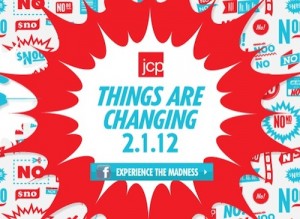After a full on rebranding, new strategic direction, and massive organizational changes designed to reinvent the retailer and improve profits, JC Penney suffered a dismal 1st quarter.
A lot exists for shareholders and stakeholders to be frustrated about – and much of it relates to organizational development and leadership (or poor leadership).
CEO Ron Johnson did have a vision – to get rid of the nonstop product promotions at the store and move to three kinds of prices (everyday, monthly specials, and clearance). He announced new designer partnerships and a new spokeswoman and advertising star, Ellen DeGeneres.
He also introduced a new logo, and new color-saturated advertisements that barely mention price. Within four years, he said, the stores would be completely redone, each divided into about 100 small boutiques with a service center that he called “town square.” Ron has vision – but what he lacks is thoughtful and holistic understanding and execution.
Change can’t be rushed
Before leaders begin making organizational changes, no matter what successful past experience at other organizations may lead them to believe, it is necessary to collect current organizational data – data from stakeholders, data from employees, and most importantly, data from customers.
Change can’t be rushed. It is said by some that a transformational change such as the one Penney’s is undertaking can take an average of seven (7) years – yup, you read that correctly. Change isn’t easy folks, and doing it right takes time; just look at Pier 1.
So – just a few things (I have quite a list but I’ll spare all the details for now as I wouldn’t want to sound like a preachy CEO) Ron Johnson should have done prior to jumping on the “turnaround CEO” bandwagon:
Data
It’s extremely difficult to turn around an organization for the better if you don’t have a recent understanding of what “better” means. Now I’m not talking about just financial numbers, web traffic, etc. as I’m sure plenty of that was collected and analyzed. I’m talking about direct from the consumer’s mouth data. Before revising pricing methods and slashing merchandise promotions, ask customers how they would feel if prices were lowered all the time across the board.
 It doesn’t necessarily matter if customers “get” your pricing as long as they’re happy with the price, product, and service. Perhaps some customers prefer the feeling of getting a bargain, maybe they enjoy coupons (as evidenced recently in this case), perhaps they don’t like receiving a large number of promotional emails and ads but a few specifically targeted to their personal buying habits.
It doesn’t necessarily matter if customers “get” your pricing as long as they’re happy with the price, product, and service. Perhaps some customers prefer the feeling of getting a bargain, maybe they enjoy coupons (as evidenced recently in this case), perhaps they don’t like receiving a large number of promotional emails and ads but a few specifically targeted to their personal buying habits.
The point here is you don’t know what the customer wants unless you ask them – so take the time to collect data on your customers needs, wants and desires and don’t just assume you (cough: the leader) knows best!
People
It’s imperative your employees have a solid understanding of why changes are taking place and how the changes impact them. Communicate with the workforce. Not just so they have an understanding of how the change impacts them, but also so you can build their commitment to the process.
Employee committment is imperative to maintain high performance and customer satisfaction during times of change. Penney’s employees, particularly the sales associates, were accustomed to a certain way of doing their jobs – selling and dealing with merchandise price cuts and promotions and customer service – in certain ways. They learned how to make a commission, when to push items, and when not to.
Personal example
I bought a massage power recliner from JC Penney. When I first saw it listed online it was one price, when I went into the store to actually see it in person it was a different price. When I didn’t commit that day the sales associate gave me his card. I called him back a week or so later and the chair was miraculously over $150 cheaper with free shipping – if I came in to purchase that week.
The sales associate knew the pricing system, he knew the price would be lowered, and he knew he could offer me free shipping as the price would probably be lowered yet again in a few more days. I felt like I got a good deal, I got my chair same day, and he made his commission of a higher amount. I was a happy customer and he was a satisfied sales associate.
If changes in process and procedures are going to occur that impact the day to day of how employees perform their jobs, then not only do you want to communicate those changes and ask for feedback – you also want to make sure you provide any needed training so they can succeed. Otherwise performance suffers, retention suffers, customer service declines, and shareholders don’t end up happy.
Accountability
Mr. Johnson seems to be coming off like a stereotypical ivory tower CEO — not an in touch and transparent leader. From what I’ve seen, his attitude regarding the current earnings announcement was a bit disingenuous. In typical financial fashion, the numbers were manipulated to try and sound somewhat positive.
Oh Ron, just own it! Be a grown up, be an honest, transparent, accountable, and authentic leader. Acknowledge that things aren’t going exactly as planned – and don’t whine and make excuses – but let us know you see it too, and tell us the steps you plan to take to reevaluate and improve. That’s what builds trust in a leader – and in my experience trust in leadership can usually be correlated to high performing organization with committed employees, loyal customers, and increased performance (I really should do a study on that, if anyone knows of one please share!)
I do enjoy the new JC Penney commercials, but I’d enjoy shopping there a lot more if I knew the retailer had honest, transparent, committed, accountable leadership who elicited and acted on customer, stakeholder and employee feedback, but hey, that’s just me.
http://www.youtube.com/watch?v=k5F7NG8vBOQ
This was originally published on the Tolero Think Tank blog.
